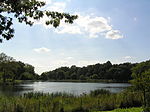Pomonok Country Club
Pomonok Country Club was a country club in the northeastern United States, located in what is now the Pomonok neighborhood of the New York City borough of Queens. The golf course was located between Kissena Boulevard and 164th Street, just to the south of Horace Harding Boulevard (now the Long Island Expressway) and to the east of Queens College.The club was established in 1886 by members of the Flushing Athletic Club in southern Flushing and moved to the Kissena Boulevard location in 1921. Devereux Emmet designed the golf course; the members disbanded and sold the course in 1949. Part of the site today contains the Electchester cooperative housing development, Pomonok public housing, and an extension of Parsons Boulevard.The golf course hosted the PGA Championship in 1939, in which Henry Picard defeated Byron Nelson in the final in 37 holes. The match play event was held in July during the New York World's Fair, which was located at Flushing Meadows–Corona Park, approximately two miles (3 km) northwest. The former course of Fresh Meadow Country Club was a few miles east (40.733°N 73.78°W / 40.733; -73.78); it hosted the PGA Championship in 1930 and the U.S. Open in 1932. That course was sold in 1946 for development and the club moved to Lake Success, five miles (8 km) northeast.
Excerpt from the Wikipedia article Pomonok Country Club (License: CC BY-SA 3.0, Authors).Pomonok Country Club
Parsons Boulevard, New York Queens
Geographical coordinates (GPS) Address Nearby Places Show on map
Geographical coordinates (GPS)
| Latitude | Longitude |
|---|---|
| N 40.734 ° | E -73.81 ° |
Address
Parsons Boulevard 67-11
11365 New York, Queens
New York, United States
Open on Google Maps




